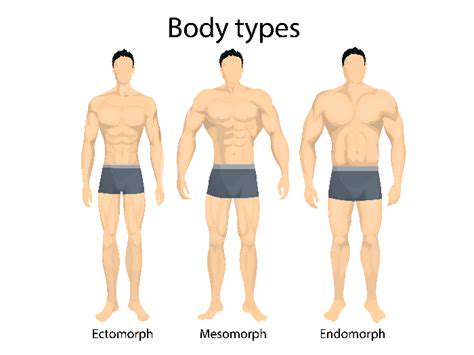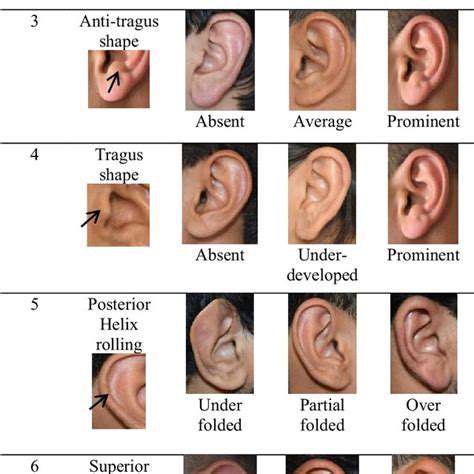Understanding Ectomorphs: The Lean and Lanky Build
Ectomorphs are often characterized by their lean, slender frames. They typically have a small bone structure, a relatively low body fat percentage, and a rapid metabolism. This combination often leads to challenges in gaining weight, both muscle and fat, which can be frustrating for those seeking to build a more robust physique. Understanding the unique characteristics of ectomorphs is crucial for developing a balanced and effective fitness routine tailored to their specific needs. This includes strategic approaches to nutrition, focusing on calorie-dense foods and regular, consistent meals to support growth and development.
Achieving a healthy balance for ectomorphs frequently involves mindful eating habits and a structured approach to exercise. They may need to consume more calories than their counterparts to support muscle growth and overall well-being. The focus should be on nutrient-rich foods, including lean proteins, complex carbohydrates, and healthy fats. This approach can help to maintain a balanced diet that supports a healthy lifestyle. Consistent workouts that incorporate resistance training are essential for building muscle mass and optimizing body composition. A balanced approach that considers the individual needs and challenges of ectomorphs is vital for long-term success.
Embracing Mesomorphs: The Naturally Athletic Build
Mesomorphs often possess a naturally athletic build. They typically have a well-proportioned physique with a relatively easy time gaining and maintaining muscle mass. Their metabolism is often more efficient than that of ectomorphs or endomorphs, contributing to their ability to build muscle and maintain a healthy weight. Maintaining this naturally athletic build often involves a balanced approach to nutrition and exercise to maintain the physique while preventing excessive muscle gain or loss.
While mesomorphs often find it easier to gain muscle, maintaining a healthy balance is still crucial. A balanced diet that supports their active lifestyle and muscle growth is essential. This often involves a strategic approach to protein intake, ensuring adequate amounts to support muscle repair and growth. A well-rounded exercise routine, combining both cardio and strength training, can help to maintain the desired physique and prevent imbalances. It's important to listen to the body and adjust the routine as needed to support its unique needs.
Maintaining a healthy balance for mesomorphs involves a conscious effort to prevent imbalances. This includes adjusting the diet and exercise routines to support the individual's needs and prevent overtraining or under-nutrition. Careful monitoring and adjustments can help mesomorphs maintain their natural athletic physique and overall well-being.
Identifying the Three Primary Body Types in TCM

Understanding the Core Components
The human body, a marvel of biological engineering, is composed of three primary components: the musculoskeletal system, the nervous system, and the circulatory system. Each plays a crucial role in maintaining homeostasis and enabling movement, sensation, and the transport of essential nutrients throughout the body. Understanding these systems is fundamental to comprehending overall health and well-being.
These interconnected systems work in harmony, influencing each other's function and responding to the constant demands of the environment. Disruptions in any one of these systems can have widespread consequences, impacting the body's ability to maintain optimal function.
The Musculoskeletal System: Support and Movement
The musculoskeletal system, comprising bones, muscles, tendons, and ligaments, provides the structural framework for the body. It enables movement, protects vital organs, and stores minerals crucial for maintaining overall health. The intricate interplay of bones, muscles, and joints allows for a wide range of activities, from simple tasks like walking to complex movements like playing a musical instrument.
Strong bones and muscles are essential for preventing injuries and maintaining mobility throughout life. A proper diet rich in calcium and vitamin D, along with regular exercise, are paramount in supporting the health of this vital system.
The Nervous System: Control and Coordination
The nervous system, encompassing the brain, spinal cord, and nerves, acts as the body's control center. It receives information from the environment, processes it, and sends signals to the muscles and organs to initiate appropriate responses. This intricate communication network governs everything from basic reflexes to complex cognitive functions.
This remarkable system allows us to experience the world around us, from the simple sensation of touch to the complex emotions and thoughts that shape our consciousness. Understanding the workings of the nervous system is crucial for addressing neurological disorders and improving overall well-being.
The Circulatory System: Transportation and Regulation
The circulatory system, comprised of the heart, blood vessels, and blood, is responsible for transporting oxygen, nutrients, hormones, and waste products throughout the body. This vital network ensures that cells receive the necessary resources to function optimally and that waste products are removed efficiently.
The heart, the driving force behind this system, tirelessly pumps blood throughout the body, delivering life-sustaining substances to every cell. This continuous circulation is essential for maintaining a stable internal environment and supporting overall health.
Interconnectedness and Interdependence
The three primary body systems—musculoskeletal, nervous, and circulatory—are intricately interconnected and interdependent. For instance, the musculoskeletal system provides support for the nervous system, while the nervous system controls the movement of muscles in the musculoskeletal system. The circulatory system delivers oxygen and nutrients to all these systems, ensuring their optimal function.
Disruptions in one system can have cascading effects on others. For example, a lack of oxygen due to a circulatory problem can impact the nervous system, leading to various neurological symptoms. Understanding these intricate relationships is key to comprehending the complexities of human health and disease.
Maintaining Optimal Health
Maintaining a healthy lifestyle that encompasses proper nutrition, regular exercise, and stress management is crucial for supporting the optimal function of all three primary body systems. A balanced diet rich in essential nutrients provides the building blocks for strong bones, muscles, and nerves.
Physical activity strengthens the musculoskeletal system and improves cardiovascular health, while stress management techniques can help maintain a healthy nervous system. Prioritizing these lifestyle factors can significantly contribute to overall well-being and prevent various health problems.
The Importance of Prevention
Early detection and prevention of potential health problems play a crucial role in maintaining the health of the three primary body systems. Regular checkups, screenings, and adherence to recommended health guidelines can help identify and address potential issues early on.
Proactive measures, such as maintaining a healthy weight, avoiding smoking, and limiting exposure to harmful substances, can significantly reduce the risk of developing various diseases that can impair the function of these essential systems. Taking preventative steps is key to ensuring a long and healthy life.
Exploring the Phlegm Body Type: Characteristics and Implications

Understanding the Phlegmatic Temperament
The phlegmatic body type, often associated with the phlegmatic temperament, is characterized by a calm, even-keeled nature. Individuals with this constitution tend to be relaxed and adaptable, often displaying a tranquil demeanor. This doesn't mean they're passive; rather, they're typically steady and reliable, approaching tasks with a consistent and deliberate approach. They are generally good listeners and enjoy maintaining harmony in their relationships.
Phlegmatics are known for their patience and composure, often excelling in roles that require a steady hand and a calm approach to problem-solving. They are generally good at handling stress and maintaining a sense of equilibrium, making them valuable assets in collaborative environments.
Physical Characteristics of the Phlegmatic Body Type
While the term body type often refers to physical attributes, it's important to remember that the phlegmatic constitution isn't solely defined by outward appearance. Instead, it's more accurately described as a combination of physical, emotional, and mental characteristics. However, some common physical traits often associated with this type include a generally relaxed physique, a tendency toward a moderate build, and smooth, even skin tones. Their physical presence often reflects their overall calm and steady nature.
Furthermore, individuals with this constitution often exhibit a moderate metabolism, which can affect their weight management. The phlegmatic temperament tends to lean towards a more moderate and consistent pace of life, both physically and emotionally.
Lifestyle and Health Considerations for Phlegmatics
Maintaining a healthy lifestyle is crucial for individuals with a phlegmatic constitution. Given their generally relaxed nature, they may need to be mindful of their activity levels to avoid stagnation. Regular exercise, even moderate activity, can help maintain a healthy weight and energy levels. A balanced diet rich in fruits, vegetables, and whole grains is also vital for overall well-being. Maintaining a strong social network and engaging in activities that promote relaxation and mindfulness can also contribute to their overall health and happiness.
It's also important for phlegmatics to address potential health concerns associated with a more sedentary lifestyle and a tendency towards a moderate metabolism, such as maintaining a healthy weight and monitoring blood pressure. Regular check-ups with a healthcare professional are essential for early detection and preventative measures.
When dealing with a suspected fracture in a pet, immediate immobilization is crucial. This prevents further damage and pain to the injured limb. Never attempt to manipulate or straighten the limb yourself, as this could worsen the fracture and cause additional injury. Instead, gently and carefully support the injured limb in its current position using a supportive material, such as a rolled-up towel or blanket.
Understanding the Liver Body Type: Emotional and Physical Traits
Understanding Emotional Traits
The liver body type is often associated with a strong emotional nature, sometimes manifesting as a tendency towards anxiety, irritability, or even anger. Individuals with this constitution might struggle with expressing their emotions openly, potentially leading to feelings of frustration and pent-up tension. This emotional reserve can sometimes manifest as a need for control and a desire to maintain a calm exterior, even when experiencing internal turmoil. However, this doesn't mean they are not capable of deep empathy and compassion; rather, they may need to develop healthier strategies for processing and expressing their emotions.
Furthermore, individuals with a liver body type may experience heightened sensitivity to their surroundings, leading to a heightened emotional response to stressors. This sensitivity can sometimes manifest as a need for quiet time and solitude to recharge and restore emotional equilibrium. Understanding these emotional patterns can help individuals with this body type to develop coping mechanisms that facilitate emotional well-being and prevent emotional overwhelm.
Physical Characteristics
Physically, the liver body type is often characterized by a tendency towards a leaner build, although this can vary. Individuals with this type frequently exhibit a strong constitution, capable of enduring physical exertion. However, it's essential to acknowledge that each individual's physical characteristics are unique, and not every individual with a liver body type will have the same features. Sustaining a healthy lifestyle, including proper nutrition and regular exercise, is crucial for maintaining physical well-being, regardless of body type.
Digestive issues and liver-related problems can be potential concerns for individuals with this body type. This highlights the importance of maintaining a balanced diet and addressing any digestive issues promptly to prevent exacerbating these potential vulnerabilities. Regular checkups with healthcare professionals are vital to ensure overall health and well-being.
Dietary Considerations
A healthy diet is paramount for supporting the liver's role in detoxification and overall health. Individuals with a liver body type often thrive on foods that are fresh, light, and easily digestible. This might include fresh fruits, vegetables, and lean proteins. Avoiding excessive consumption of greasy, fried, or processed foods is crucial for maintaining liver health. Furthermore, staying hydrated is essential for optimal liver function. A diet rich in nutrient-dense foods can help support the liver's crucial detoxification processes.
Lifestyle and Wellness Strategies
Maintaining a balanced lifestyle is essential for optimal well-being for individuals with a liver body type. This includes prioritizing sufficient rest and sleep, engaging in regular physical activity, and seeking opportunities for stress reduction. Finding healthy ways to manage stress, such as meditation, yoga, or spending time in nature, can significantly contribute to emotional and physical well-being. Regular exercise can also help regulate mood and improve overall physical health. Furthermore, nurturing strong social connections can foster a sense of support and belonging, potentially mitigating stress and promoting emotional well-being.